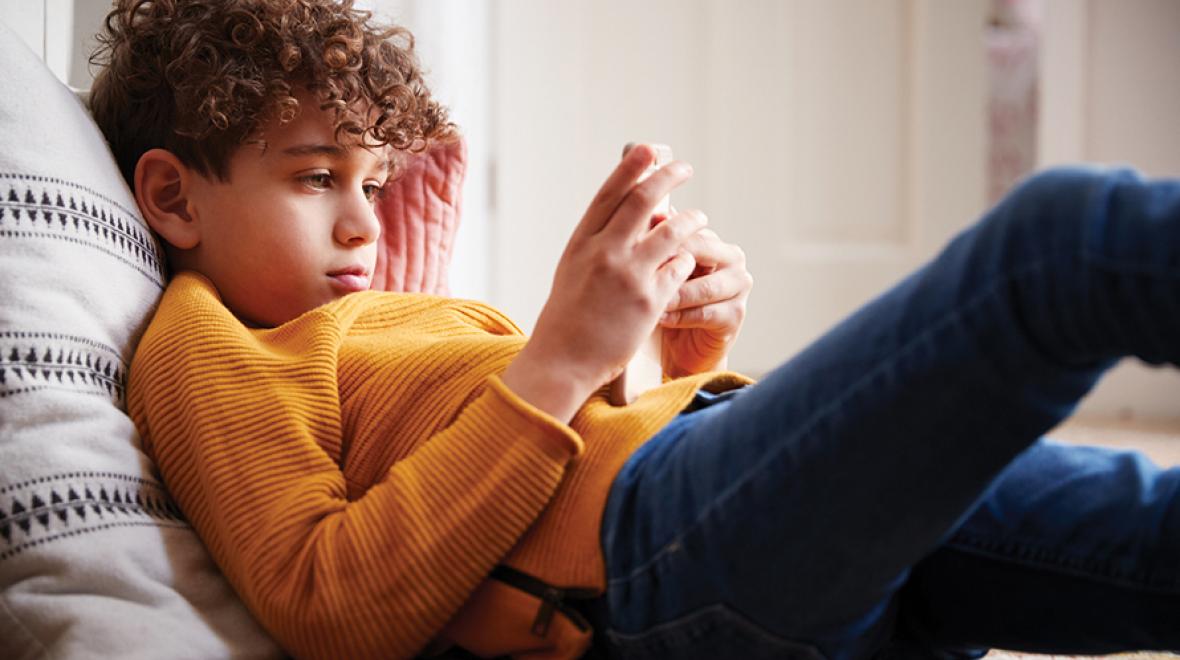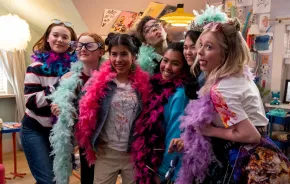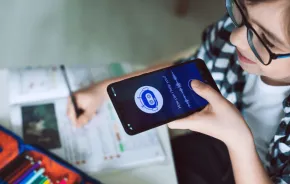
After the year we just had, it’s a bit much to expect parents to set any sort of hard-and-fast New Year’s screen-time resolutions.
We, as parents, are completely drained. Many of us were barely keeping it all together before COVID-19 struck, so now, after the onset of remote learning, summer camp dropouts and yet more remote learning, we’re simply done.
(And our poor teachers! This isn’t what they signed up for at all. They are working so hard to make this bad situation better, often while dealing with the unexpected, such as when my nephew, who was asked to practice using his iPad to take and upload pictures, snapped a photo of his own nipple and the dog’s butt. Oops!)
I get it. I’m a teacher and I’m a parent, not to mention I’m nominally “The Screentime Consultant.” I, too, have reached the end of my rope more than once during these past months. I have done things I regularly implore parents not to do — for instance, threatening to take away screen time. I have modeled the very behaviors I wish my children to eschew, such as using my phone as a distraction. I have even tossed my hands up and caved when my children have demanded, “Just one more episode” or petitioned their need to “just finish this level,” because I didn’t want to fight anymore.
My website’s motto is “Stop fighting, find balance,” but right now, even I can’t say that I have achieved that goal at home.
So, perhaps it is the height of absurdity for me to presume to write an article advising parents to set New Year’s resolutions regarding screen time. But I am deep in these trenches, too, and while I may be as burned out as the next parent, I do have some knowledge and tools that might be useful to others in this unfolding reality of 2021.
If you haven’t tossed the tablet out the window in anger or given in entirely to an all-screens, all-day policy (or even if you have), then here are some realistic, tangible options.
Own it: Live your tech life out loud.
Parents utilize screens more than ever before, just as their kids do. Working from home coincides with managing remote learning, scheduling online dance classes and moderating Zoom “playdates,” while also trying to assess if playing Minecraft after school constitutes the same, or a different, version of screen time than school does. It is all very confusing. Parenting was already a full-time curator’s job, and now, we’re all squeezed together into tighter quarters, trying to keep calm and carry on.
This year, resolve to just own it. Tell your kids that this chaotic mess is stressful for you, that it’s hard to manage, and that you just don’t always know what the right thing to do is. Admit that you’re on your computer or staring at your phone more than you’d like. Talk about how social media and doomscrolling have allowed you to swap at-home chaos for real-world chaos, and, at the very least, how those distractions are welcome in the short term.
How do you do this? Narrate what you do as you do it. This act of “living your life out loud” is actually a secret weapon. It’s free, it’s easy to do, and even if your kids roll their eyes, it’s actually teaching them some really valuable skills, namely those pesky but important executive functions (organization, planning, prioritizing, emotion regulation, among others) that are so often touted as the backbone of healthy development.
Here are some easy prompts to get you started:
- “Ugh. My work emails are so overwhelming. I feel like scrolling through Instagram to distract myself.”
- “Hmm ... that 20 minutes on IG turned into an hour, and I don’t feel better.”
- “I am looking at this cooking app for inspiration on what to make for dinner, though honestly, I want to order pizza again because I am so tired of cooking.”
- “I am binge-watching old episodes of ‘The Great British Baking Show’ because it helps me feel like there are kind people in the world.”
Living out loud can feel awkward at first, but keep trying. We want our kids to see how we use tech — the good, the bad and the pandemic. When they understand that we struggle, too, they can learn from how we build resilience after rebounding from bad choices.
Choose connection and small moments.
A few months ago, my daughter and I were in constant conflict, both of us stressed, tired and stubborn. The smallest things sparked big blowups. One day, I made a bid to connect with her in a tense moment. I reminded myself that she is not a small adult, but a child with big feelings and fewer skills to regulate them. She leaned into me, burst into tears and said, “I just want to play with you!”
Heart. Breaking.
Kids are doing such an amazing job. They don’t complain about wearing masks or keeping 6 feet away from others, even when that goes against the very nature of being a child. Yes, they are also sad and lonely, and they miss their friends and teachers, but as one of my dear friends always says, we can learn a lot from kids when it comes to “controlling our controllables” — something that is even more relevant now.
This year, stop worrying about orchestrating family outings to “make up” for what your kids have lost. Accept the fact that PB&J is on the menu for lunch again and that the Halloween candy is still being consumed. Celebrate the unplanned moments — that socially distanced bike ride in the empty school parking lot with a neighbor or an impromptu Lego-building session. There’s a good chance our kids will look back on some of these memories fondly, in spite of the chaos.
What our kids need most now, and what they have needed most all along, is time to connect with us. In all our messy exhaustion. In the middle of bulldozing that endless pile of laundry or toys. In spite of all that excessive screen time. In spite of the lack of vegetables on the dinner plate.
What our children need most is 10 minutes — even just five minutes — daily of our eye contact, our words, our hands, our presence. Rather than death by a thousand cuts, we can choose life by a thousand small moments.
Then they can have the iPad back.
Say no … sometimes.
Things won’t be like this forever. Eventually, our kids will be back in the classroom. They will resume in-person activities. And the way we use screens will continue to evolve, for better and for worse.
Sometimes we can say yes to screens, and maybe, right now, we’re saying yes more often than we did during pre-COVID times. But remember that “yes” in 2021 can look different than it did in 2020 — or in 2019, for that matter. The end of the pandemic is in sight. We might want to think about how to start tapering the yeses in favor of a few more noes.
Let’s think in terms of baby steps, of course. Nothing dramatic or cold turkey. But parents can say no to screens. Unless your 5-year-old paid for the device and all those related service charges by herself, you own the iPad and therefore, you are still in charge.
I do understand that it can be easier to say yes, and when we are stressed, we might lean that way. That’s totally understandable. But as obvious as it may seem, saying yes sometimes means that at other times, we get to, and should, say no. Think of it as a golden ratio of screen time: For every two yeses, add a no.
Keep in mind that saying no, as unpleasant as the ensuing meltdowns could be, is actually good for our kids. Why? Because boredom begets creativity, which means that your littles now get to make their own fun. If the tantrums really get to you, go back to precept No. 1, about living your life out loud: “I can see that my decision upsets you. I’m going to step outside for a deep breath. If you want my help in thinking of a different activity, let me know, but you are full of good ideas!”
When I started answering with more noes than yeses, my own kids began playing with toys that I’d thought they’d outgrown: Playmobil and Lego, wooden blocks and dolls. One of the biggest issues with screen-based play is that the “fun” is generated by an algorithm or a technology company. In free play with traditional toys, children drive the storyline.
And even if the kids’ free play is building iPhones out of Legos, at least the projects are three-dimensional.
Sigh.
Practice tech intentionality.
I like chocolate as much as the next burned-out parent, but I don’t eat it every day (unless it’s near Halloween and there are Reese’s Peanut Butter Cups in the house). But even seasonally bingeing on a favorite candy is, well, seasonal. It isn’t something I do every day, because I want to appreciate it for the occasional treat that it is.
In much the same way, screen time is like a box of chocolates, in the sense that you shouldn’t have it all day every day, even if you want to. When parents ask me, “How much screen time is too much?” I reply, “A little is okay, and a lot is too much.” So annoying, I know. But the truth is, the prescription is different for different kids and different ages and different content. The bigger question is how to handle screen-time challenges with minimal stress. For this newly hatched year, consider a “tech-intentional” approach.
We often turn to our screens as a way to access information quickly. This is definitely one of the perks of a smartphone. But being “tech-intentional” can mean thinking about alternatives to getting that information and wondering if the quickest is always best. (Learning happens when we struggle, after all!)
For example, if your kids want to look up a recipe to bake cookies, instead of a quick Google search, grab a cookbook off the shelf. Or put on your mask, walk to your favorite local bakery and ask for tips. Or use the phone (with its call-an-actual-human capability!) to reach Aunt Susan, who makes the best cookies, and have her walk you through the recipe. (And write it down on a piece of actual paper!)
Or consider how your family might come to rely on a paper map (you probably have some stuffed in the glove compartment somewhere, right?) to navigate to your next destination. Sure, the map won’t verbalize step-by-step directions, but your child can learn his location relative to other places in the area where you live. (Even little kids can have fun pretending to read a map!)
Be intentional about how often your kids are exposed to targeted marketing. As Josh Golin, executive director of the Campaign for a Commercial-Free Childhood, has wisely pointed out, marketing companies know a lot and they use that information to target us. For example, when your child watches “Paw Patrol” on TV, marketers know he is watching “Paw Patrol.” But when your child watches “Paw Patrol” on YouTube, marketers know what video he’s watching, what he watched before that video, what he watched yesterday, what other websites he goes to and how often, what games he plays, what characters he likes, who his friends are, who his parents are and how much money they have, how old he is and where he lives.
In this case, being tech-intentional means electing to watch “Paw Patrol” on TV instead of YouTube and having conversations with your kids about the ways in which marketing influences the ads and recommendations of algorithm-driven YouTube.
That said, you might not want to live your life out loud when you use Amazon to build their holiday wish lists.
The only way out is through.
The year 2020 was not remotely what we expected. The year 2021 probably won’t be either. But my mantra these days is “The only way out is through.”
More often than not, our use of screens during the pandemic, by necessity, has probably veered into survival mode and pure practicality. On the one hand, technology has assisted us in staying connected to loved ones, schooling our children, working from our homes and entertaining ourselves during downtime. On the other hand, Zoom fatigue is real, remote learning is mostly a bummer, trying to “work” at home is impossible at times, and Netflix binge-watching isn’t always a healthy coping mechanism.
The reality is that we can always do better, and right now, “better” may be set at a pretty low bar. That’s okay. That means we can start to gently, intentionally, raise that bar, one day at a time.
One way to start moving through this is to use time-bound language when it comes to screen use. Just because our children are spending hours on screens for remote learning and entertainment doesn’t mean things will always be this way. We can say to our kids, “Right now, we are using screens a lot. When we return to school, we will readjust how much we use them,” or “During a pandemic, a lot of things have changed, including how much screen time we get. When it is over, we will be able to better balance screen use with other things we enjoy doing.”
As much of a struggle as remote learning has been for many families, children are still learning, even if what they are assimilating isn’t always part of the official curriculum. The child of a friend is required to track time spent listening to audiobooks in his school’s online platform for points (ugh). My friend recently found him watching a show on Netflix with his school iPad next to him, an audiobook playing on mute. How clever!
The answer to how much is too much is never black and white. We are going to mess up, but that would be true even if we weren’t experiencing a pandemic. For many families, this crisis has forced us to slow the hamster wheel long enough to remember what we love about being with our kids, to revisit shared activities like neighborhood walks, to reimagine what family time can look like and even to find unexpected ways to connect with each other.
The long-term fallout from the COVID-19 pandemic will be huge — the mental health of those who are isolated, the extreme demands visited on our first responders, the educational toll on our youth of being kept at a distance from beloved teachers for so long, the political strife that has worsened our entire experience. But we are resilient. Children are resilient.
We used to get out of bed in the morning because we knew, as our parents did, that we wanted to leave the world a better place for our kids. Now, we get out of bed because our kids are helping us to realize that, together, we can all make the world a better place.
At least until they want the iPad back.











